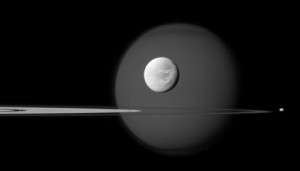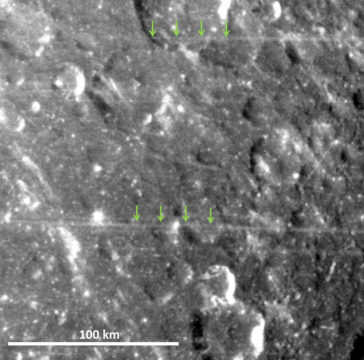Long straight parallel lines on the satellite's surface could be droppings from Saturn's rings, one of the moons, or a passing comet, researchers suggest.

NASA / JPL-Caltech / Space Science Institute
Saturn’s moons are a hodgepodge of misfits. Iapetus looks like the Death Star from Star Wars. Tiny Pan resembles a cosmic empanada. And now something appears to be etching oddly straight lines across the icy surface of Dione.
The lines — or linear virgae, to use the proposed technical term — stretch for up to hundreds of kilometers, and yet are less than 5 kilometers wide. They all run parallel to the equator and reside only at lower latitudes. They are brighter than everything else around them and appear to be laid atop extant features such as ridges and craters, which means they’ve been emplaced fairly recently. And it’s not clear yet how they got there.
“We are not really sure how to get such straight lines,” says Emily Martin (National Air and Space Museum), coauthor on an upcoming paper describing the surface scoring in Geophysical Research Letters. “Linear virgae are really unlike anything else we see in the solar system.”

NASA / JPL-Caltech / Space Science Institute / E.S. Martin and D.A. Patthoff, 2018
Moons aren’t strangers to distinctive surface markings. Saturn’s moon Enceladus has its famous tiger stripes, wavy ridges through which water erupts from an underground ocean. Neptune’s moon Triton has dark streaks, likely marked by deposits from plumes. Lines of debris radiate away from craters throughout the solar system. Even our Moon has got scalloped troughs carved by boulders rolling down hills.
Martin and coauthor Alex Patthoff (Planetary Science Institute) considered all these scenarios and more for Dione, but none seem to work. Dione’s lines are too long, too wide, too bright, or placed too weirdly.
The placement parallel to the equator suggests that the most likely culprit is something that was already in the same plane as Dione’s orbit and then gently rained down on the surface.
That leaves only a few options. Material from Saturn’s rings could be sprinkling down, though it’s not clear what mechanism would drive material out away from the rings and toward Dione. There could be some transfer of material from satellites Helene or Polydeuces, the moons that share Dione’s orbit. Or perhaps the lines are debris from a comet that just happened to pass by.
“If we can find linear virgae elsewhere in the Saturn system, we might learn a little more about the sources for material that could drape across the surfaces of these moons,” Patthoff says. “We don’t have a chance to get more images right now, but we can explore the whole archive of images that we do have from Cassini.”
Reference:
E. S. Martin and D. A. Patthoff. "Mysterious Linear Features across Saturn's moon Dione." Geophysical Research Letters. October 15, 2018.
 4
4









Comments
Robert-Casey
October 29, 2018 at 2:41 pm
looks like a camera artifact, but I'm sure scientists thought of that.
You must be logged in to post a comment.
Peter Wilson
October 29, 2018 at 9:25 pm
Striking resemblance to Nasca lines in Chile, pueblo lines in northern Arizona, and an Zogothian "paintball" playing field...
You must be logged in to post a comment.
Mike-Edmunds
November 2, 2018 at 4:45 pm
Mimas looks like the Death Star. Iapetus is just plain weird looking.
You must be logged in to post a comment.
Stub Mandrel
November 5, 2018 at 4:28 pm
Most of them may be parallel; to the equator but there is a clear one sloping down left to right at about 25 degrees and another at right nearer fifty degrees.
So either the proposed mechanism is wrong or something else is happening as well...
You must be logged in to post a comment.
You must be logged in to post a comment.